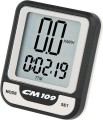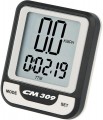Type
The type determines, first of all, the method of communication with the remote wheel speed sensor. Recall that most bike computers are equipped with such a sensor, it is mounted on a fork, and a special magnet is attached to the wheel; when the wheel rotates, the device detects the passage of the magnet past the sensor and determines the revolutions by their frequency. The connection options are:
—
Wired. The advantages of a wired connection are low cost, reliable connection, and the fact that the speed sensor does not require its own battery. And the battery of the computer itself with such a connection “lives” longer than with a wireless one. On the other hand, such devices are somewhat less convenient to install than wireless ones, and in case of an unsuccessful fall or collision, there is a risk of breaking the wire.
—
Wireless. Such a connection allows you to do without unnecessary wires, which greatly simplifies the installation of the bike computer. At the same time, it costs more than a wired one, and two batteries are used in such a system — in the computer itself and in the speed sensor, and you will have to monitor both. Also, if there are many other wireless cycling computers nearby, the connection may fail.
Indications
Readings that can be displayed on the cycle computer display.
—
Current speed. Displays the speed of movement at a given moment.
—
Average speed. Display of the average speed of movement for a certain period, usually from the beginning of the trip to the current moment. The computer calculates this speed using the formula "total distance divided by total time." Note that in such calculations, only the time in motion can be taken into account, without intermediate stops (except for the shortest ones).
—
Maximum speed. Displays the maximum speed reached for a certain period — for a trip, for a day, for all the time since the last reset, etc. The specific features of this function in different models may vary, they need to be specified separately.
—
Ratio current/average speed. The ratio of the speed of the trip at the moment to the average speed for the entire trip. This function allows you to evaluate the current pace of movement and compare it with the pace in the already passed section.
—
Current distance travelled. Displays the distance traveled since the start of the trip.
—
Daily distance travelled. Displays the distance traveled for the current day. The change of day of the model with this function i
...s monitored by its own clock (see "Functions").
— Total distance travelled. Displays the total distance traveled since the last reset of the cycling computer. In some models, it may be possible to reset this counter without a general reset.
— Current travel time. Displays the time elapsed since the start of the current trip. Usually, the countdown starts from the moment the movement starts; during short stops, it can continue or be paused, these points should be clarified separately.
— Total travel time. Displaying the total time spent in motion for a certain period — usually since the last reset of the bike computer settings (or resetting this counter separately, some devices have such an option). Usually, only the time in motion is taken into account, excluding intermediate stops, with the exception of the shortest ones, up to half a minute to a minute.Sensors
—
GPS module. The built-in GPS satellite navigation module is responsible for determining the current geographic coordinates of the device. How this data is used can vary. With some models, using GPS, the accuracy of speed and/or distance measurements is increased, others are able to record tracks of the routes traveled, which can be viewed on an external device or even on the bike computer itself. GPS data can also use an
altimeter. And in the most advanced models, even full-fledged navigation with built-in maps is supported.
—
Bluetooth. A wireless communication technology used to connect directly between different devices. The most popular application for such a connection is to connect a wireless sensor (see "Type"); in this case, one of the advantages of Bluetooth is its excellent noise immunity and the almost zero chance of overlapping different signals one on another, even with an abundance of wireless devices nearby. In addition, Bluetooth can be used to connect to a smartphone / PC (see "Functions"), as well as for more specific purposes, such as connecting a wireless headset and receiving voice prompts from a GPS navigator.
—
Thermometer. Sensor for determining the ambient temperature. It can be useful both for assessing the current situation (for example, if a cyclist gets into the saddle hot after a warm-up
...and is not sure about his perception of temperature), and, in some cases, for predicting the weather.
— Altimeter. Sensor to determine the current altitude above sea level. Altitude can be determined by two main methods: barometer and GPS (see relevant paragraphs). In the first case, the pressure difference between the reference and current altitude is determined; in the second, a database is used about the height of the terrain with certain coordinates. The height designation format can also be defined: in some models it is indicated relative to sea level, in others it is relative to a conditional zero point specified by the user. Anyway, the information from the altimeter can be useful for assessing the elevation changes during the trip.
— Heart rate monitor. Ability to determine the current heart rate. The pulse is one of the most important parameters for more or less serious training; for different purposes (weight loss, keeping fit, gaining muscle mass), it is required to maintain different heart rates during exercise (its specific value can be determined using special methods). The heart rate monitor sensor is usually made remote and fixed on the body — this is due to the peculiarities of this type of measurement. Note that the mention of a heart rate monitor does not necessarily mean the presence of such a sensor in the kit — it may need to be purchased separately. Also note that the bike computer itself can support advanced heart rate monitor functions: maximum heart rate, average heart rate, signals about work in the optimal range, etc.
— Barometer. Sensor for determining the current atmospheric pressure. This information may be used for various purposes. So, in some models, the operation of the altimeter (see the relevant paragraph) is based on data from the barometer. And changes in atmospheric pressure can be a sign of certain changes in the weather — for example, a sharp "fall" in the barometer usually indicates the approach of rain.
— ANT+ support. Bike computer support for ANT+ data transfer technology. This technology has been specially developed for use with sports devices, including compact ones. It features good connection reliability and economical power consumption. In cycling computers, ANT+ can be used both to connect sensors and to connect the computer itself to a smartphone or other gadget that supports this technology. At the same time, ANT + devices are compatible with each other in terms of basic capabilities regardless of the manufacturer, which allows, for example, to supplement the bike computer with “non-native” wireless sensors if the standard ones are out of order.Waterproof
The presence
of water protection in the device and its level according to the IP standard. This feature usually means at least the ability to withstand exposure to rain without consequences, and often more advanced capabilities, up to full short-term immersion in water.
The parameter is usually designated by the letters IP and two numeric symbols after them (for example, IP54, or IP67). The numbers indicate a specific level of protection: the first - from foreign objects and dust (maximum 6), the second - from water (maximum 8). The maximum level of protection according to this standard is IP68, that is, complete waterproof.
Instead of one of the numbers, the letter X may be indicated - this means that certification for this indicator has not been carried out: for example, an IPX8 device has a moisture resistance of 8, but has not been tested for dust protection. However, a high degree of water protection automatically entails good dust resistance.

